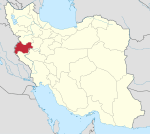Sonqor County
| Sonqor County شهرستان سنقر | |
|---|---|
| County | |
 | |
| Coordinates: 34°50′N 47°30′E / 34.833°N 47.500°ECoordinates: 34°50′N 47°30′E / 34.833°N 47.500°E | |
| Country |
|
| Province | Kermanshah |
| Capital | Sonqor |
| Bakhsh (Districts) | Central District, Kolyai District |
| Population (2006) | |
| • Total | 95,904 |
| Time zone | IRST (UTC+3:30) |
| • Summer (DST) | IRDT (UTC+4:30) |
| Sonqor County can be found at GEOnet Names Server, at this link, by opening the Advanced Search box, entering "9206875" in the "Unique Feature Id" form, and clicking on "Search Database". | |
Sonqor County (Persian: شهرستان سنقر; }) is a county in Kermanshah Province in Iran. The capital of the county is Sonqor. The name is Turco-Mongolian, meaning an "osprey". At the 2006 census, the county's population was 95,904, in 23,755 families.[1] The county is subdivided into two districts: the Central District and Kolyai District. The county has two cities: Sonqor and Satar. The majority of the people in this county is Kurds and Azerbaijanis.[2]
Kollyaii refers to the regions Songhor سنقر and Koliai ( کلياي ). Kollyaii is a mountainous county in Kermanshah Province, which is in the west of Iran. According to 1996 census, Sonqor had a population of 112,214. It consists of two districts: the central district (Songhor and Koliai) and nine townships. The city of Sonqor, which serves as the governmental seat of Kulliye, is 85 km northeast of Kermanshah. It is 1,700 meters (5,500 feet) above sea level and has a rather cold climate.
Historically, the people in the city of Sonqor are said to have descended from the qizilbash, who were the Safavid's Imperial Royal Guard, tasked with the protection of the house of Kulliye's Beghwand/Bigvand family. The guards spoke the Turkic language of the Qizilbash Turkmen, which was the language of the Safavid's court ; while the surrounding townships and villages of Koliai (Kulliye) were speaking the Kurdish dialect of Gorani language mixed with Kalhori (this dialect is locally known as "Koliai"). However, in recent years, the Kurdish population in Sonqor has increased considerably.[3]
Historical figures
The most prominent historical figures of this region are from Bigvand (Beghwand) dynasty of Koliai. Prominent "ashair" of Koliai, such as the Amiri-Bigvand, Amjadi-Bigvand, Farhang-Bigvand and Qubadi-Bigvand, played an important political and religious role from Safavid times[4] to the mid-20th century. The most famous among these are Hasan Pasha Khan, father of Housain Quli Khan Amir Amjad and Nadali Khan; Hasan Pasha Khan's brother Amir Toman, father of Sardar Ashraf Amiri-Bigvand (Beghvand); Salar Mansour Amjadi-Bigvand who were the brave rulers (Amir/Haakem/Begh/beygs) of this region in the early 20th century. They are direct descendants of the Safavid dynasty's Shah Abbas II (1642–1666). From his descendants come the noble dynasty of Bigvand Kulyai (Beghwand Külliye). They survived execution attempts during Shah Abbas, escaping from captivity to the region named after them, Kulliye.[5]
External links
- Sheikh/Shaikh Safi-ad-din Is'haq Ardabili (of Ardabil) (1252-1334 Persian: شیخ صفیالدین اردبیلی )
- Mohammad Ali Soltani"Historical Geography &Comprehensive History Of Kermanshahan", 1993-Tehran
- Kuliai;lt:Kuliai
- Website of CHHTO of Kermanshah
- Kulliye
- Refer to Cambridge University Vol 6. Beghvand Kulliye, or ( Safi Khan ) was the son of Shah Abbas, and the head of the family( Bigvands) Bigvand Tribe (from Kermanshah region)
References
- ↑ "Census of the Islamic Republic of Iran, 1385 (2006)". Islamic Republic of Iran. Archived from the original (Excel) on 2011-11-11.
- ↑ http://www.iranicaonline.org/articles/turkic-languages-overview
- ↑ Unlike many other dynasties founded by warlords and military chiefs, one of the unique aspects of the Safavids in the post-Islamic Iran was their origin in the Islamic Sufi order called the Safaviyeh. Safavid
- ↑ Iran Chamber
- ↑ It was Safavids who made Iran the spiritual bastion of Shi’ism against the onslaughts of orthodox Sunni Islam, and the repository of Persian cultural traditions and self-awareness of Iranianhood.Persianate society
- اطلس گیتاشناسی استانهای ایران [Atlas Gitashenasi Ostanhai Iran] (Gitashenasi Province Atlas of Iran)
